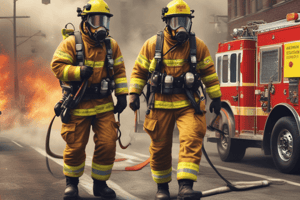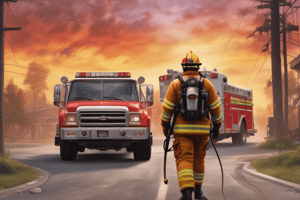Podcast
Questions and Answers
What is the purpose of the New Lenox Fire Protection District's emergency response policy?
What is the purpose of the New Lenox Fire Protection District's emergency response policy?
- To establish penalties for traffic violations by emergency personnel.
- To maintain safety for department members and the public during emergency responses. (correct)
- To confirm the availability of fire department resources.
- To ensure environmental safety during emergencies.
Which of the following scenarios qualifies as an 'emergency response' according to the policy?
Which of the following scenarios qualifies as an 'emergency response' according to the policy?
- A routine fire drill at a local school.
- Routine traffic management during local events.
- Annual inspections of fire safety equipment.
- A report of a gas leak with potential for explosion. (correct)
What is expected from personnel when responding to an emergency with lights and sirens?
What is expected from personnel when responding to an emergency with lights and sirens?
- To ensure other drivers yield immediately to all emergency vehicles.
- To continue driving safely while maintaining due regard for all persons. (correct)
- To drive at maximum speed without regard for traffic.
- To override all traffic laws without exceptions.
What restriction is placed on personnel not authorized to use emergency lights and sirens?
What restriction is placed on personnel not authorized to use emergency lights and sirens?
During a multiple emergency vehicle response, what should operators remain aware of?
During a multiple emergency vehicle response, what should operators remain aware of?
Which of the following is NOT included in the definition of an 'emergency response'?
Which of the following is NOT included in the definition of an 'emergency response'?
What is a key responsibility of fire personnel immediately upon being dispatched to an emergency?
What is a key responsibility of fire personnel immediately upon being dispatched to an emergency?
Under what condition should emergency lights and sirens be used?
Under what condition should emergency lights and sirens be used?
What is the primary action required by a Lieutenant if they deem an emergency response to be necessary?
What is the primary action required by a Lieutenant if they deem an emergency response to be necessary?
What should emergency vehicle operators do at street intersections under normal circumstances?
What should emergency vehicle operators do at street intersections under normal circumstances?
In which situation may an emergency vehicle operator proceed past traffic signals?
In which situation may an emergency vehicle operator proceed past traffic signals?
What discretion does the authorized emergency vehicle operator or Lieutenant have regarding ongoing emergency responses?
What discretion does the authorized emergency vehicle operator or Lieutenant have regarding ongoing emergency responses?
Under what condition is it permitted for emergency vehicle operators to exceed the maximum speed limit?
Under what condition is it permitted for emergency vehicle operators to exceed the maximum speed limit?
What action should personnel take if directed by a supervisor during an emergency response?
What action should personnel take if directed by a supervisor during an emergency response?
What should an operator do when approaching an intersection and they cannot account for traffic?
What should an operator do when approaching an intersection and they cannot account for traffic?
What is the primary consideration for emergency vehicle operators when integrating speed with safety during a response?
What is the primary consideration for emergency vehicle operators when integrating speed with safety during a response?
Flashcards are hidden until you start studying
Study Notes
Emergency Response Policy
- This policy ensures safe and appropriate responses to emergencies while prioritizing the safety of both firefighters and the public.
- The policy requires compliance with Illinois laws and regulations during emergency response operations.
Definitions
- An “authorized emergency vehicle” refers to the fire department's vehicles, as defined by Illinois law.
- “Emergency response” encompasses a wide range of situations including:
- Fire, explosion, or violent rupture
- Human rescue or entrapment
- Illness or injury
- Hazardous materials release
- Flooding
- Acts of violence
- Explosives or bomb threats
- Terrorism
- Natural disasters
- Other situations posing threats to life or property.
Emergency Calls
- Fire personnel responding to an emergency must proceed immediately, activate emergency lighting equipment, and utilize sirens as deemed necessary, adhering to Illinois state law.
- Even while operating emergency lights and sirens, drivers must operate with caution and consideration for the safety of everyone.
- Emergency lights and sirens should only be utilized when responding to an emergency call, or when circumstances indicate an immediate emergency response is necessary.
- Personnel not authorized for emergency response with lights and sirens must abide by all traffic laws and proceed without the use of emergency lights and sirens.
Multiple Emergency Vehicle Responses
- When multiple apparatus respond to a situation, operators must maintain awareness of other emergency vehicles and prioritize caution.
- Drivers must acknowledge that vehicles yielding to one emergency vehicle may not expect additional emergency vehicles to follow.
Initiating an Emergency Response
- If a Lieutenant deems an emergency response to a call as appropriate, they are required to immediately notify Dispatch.
Responsibilities of Responding Personnel
- Authorized emergency vehicle operators must prioritize safety and exercise sound judgment while driving.
- Drivers must reduce speed at intersections and come to a complete stop at blind intersections or intersections with traffic signals or stop signs.
- A full stop is also required at any intersection where the driver believes they cannot safely account for traffic or when vehicles have not yielded the right-of-way.
- After a full stop, an emergency vehicle can proceed only when it is safe to do so.
Emergency Vehicle Operation
- Emergency vehicle operators may, while operating lights and sirens, legally take certain actions:
- Park or stand anywhere necessary
- Proceed past red lights or stop signs, but only after a safe, cautious slow down.
- Exceed speed limits, as long as it does not endanger life or property.
- Disregard direction of movement or turning regulations.
- The decision to continue an emergency response rests with the assigned officer or the emergency vehicle operator.
- If conditions such as heavy road traffic don't permit safe emergency response, the response may proceed without lights and sirens at the legal speed limit.
- In such cases, dispatch must be promptly informed.
- Emergency responses can also be discontinued upon the instruction of any supervisor.
Studying That Suits You
Use AI to generate personalized quizzes and flashcards to suit your learning preferences.





